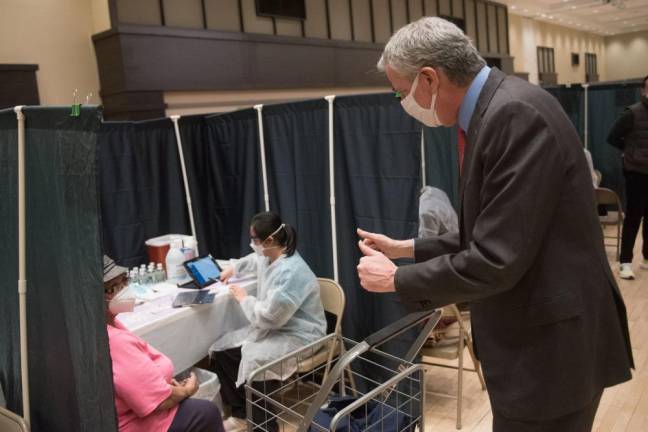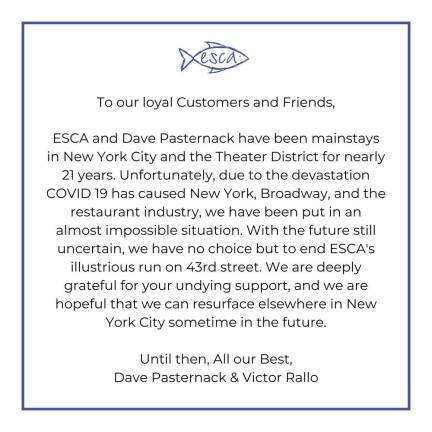If the varied versions of medical recovery from COVID-19 were used to describe economic recovery, then New York City would be the quintessential long-hauler.
This is the condition in which weakness lingers long after the acute phase has passed. Doctors have been puzzled by long-haul COVID as a medical syndrome. But as an economic condition New York’s struggle isn’t hard to explain.
The city’s economy was heavily dependent on businesses and jobs that were especially vulnerable to the ravages of COVID-19 – everything from restaurants and Broadway theater to global tourism (which, of course, are all dependent on each other). Essentially, that part of the economy you can’t work from home. The face-to-face economy.
With vaccination accelerating – and President Joseph Biden promising enough vaccine for every adult by the end of May – New York’s leaders are eagerly hailing the light at the end of the tunnel.
Mayor Bill de Blasio said the arrival of Johnson & Johnson’s one-jab vaccine would “revolutionize” the city’s immunization program. To prove his point, Fire Department staff were quickly dispatched to the “naturally occurring retirement communities” of Co-Op City and Brighton Beach to inoculate homebound seniors.
These shiny moments inspired hope, but also shrouded the long haul ahead.
“We are not at the beginning of the end of the pandemic, but rather we are approaching the end of the beginning,” said Nicholas A. Christakis of Yale, who apparently studied Churchillian oratory alongside his day job as Sterling Professor of Social and Natural Sciences. “We will put the biological and epidemiological impact behind us by the end of 2021, and then we will enter the intermediate phase when we must cope with the social, psychological, economic, and clinical destruction left behind.”
Partial Capacity
This longer view puts our present moment of tentative re-openings in perspective.
“It feels like the beginning of life getting back to normal,” Esther Branch told the New York Post as she and her boyfriend went to see “Boogie” at the AMC Empire 25 movie theater in Times Square, which was allowed to reopen Friday with limited capacity.
“Today is the first day in a year that I feel positive and confident that the city is coming back,” Dani Zoldan, owner of Stand Up NY, a comedy club on the Upper West Side, said to Shannan Ferry of NY1 after Governor Andrew Cuomo announced that clubs and small theater venues could reopen at partial capacity on April 2. Zoldan said, however, that he would not yet withdraw the lawsuit he had brought against Cuomo to force reopening. Trust, but verify.
While Branch and Zoldan were feeling positive, many others were still looking cautiously down the road ahead. The Broadway League said Broadway shows would not be returning yet, because capacity restraints made that unaffordable. But the League said “we’re glad” that other venues “will be able to open their doors and give the public a taste of what we’ve all been missing so much through these dark months.”
For some, the financial string has run out. ESCA, a celebrated fish restaurant near the corner of West 43d Street and Ninth Avenue, announced it was closing after months of waiting in vain for the return of its three main sources of customers: Broadway theater-goers, tourists and Midtown office workers. “We have been put in an almost impossible situation,” owners Dave Pasternack and Victor Rollo, posted on the restaurant’s website. “With the future still uncertain, we have no choice but to end ESCA’s illustrious run on 43d street.”
“Involuntary Part-time Workers”
Econometricians have a measure of economic pain they call the U6, a kind of unemployment rate on steroids. It measures not just the unemployed, but also those unable or too discouraged to look for work and those who are under-employed.
In the pandemic year of 2020 the U6 in New York City averaged 19.2 percent. In other words, nearly one New York worker in five was unemployed, had given up looking for work or was working short hours, “sometimes referred to as involuntary part-time workers,” the US Bureau of Labor Statistics explained.
Nationally, U6 unemployment averaged 13.6 percent across 2020. Only two states and one other city had rates as severe as New York City. They were Hawaii and Nevada, both heavily dependent, as New York is, on tourism and service related industries, and Los Angeles County, where U6 was nearly 22 percent, as movie and TV production ground to a halt along with tourism.
Christakis of Yale said there are three phases of comeback from a pandemic. He describes them much the way a medical doctor, which he is, might describe medical recovery.
“There is the acute phase, which we are slowly emerging from,” he explained in his new book, “Apollo’s Arrow.” Assuming new variant or other surprises do not set us back, the United States will enter what he calls the intermediate phase by early 2022.
This period will be shaped by millions of individual choices about everything from mask wearing to mass transit use to office work.
Christakis estimates this period will probably last until 2024. Then if all goes well, the post pandemic period will begin with whatever we have created as a new normal.
“For all we have learned about the virus through the early stages of the pandemic there is still colossal uncertainty about exactly how it will continue to change the shape of our society in the coming years,” he wrote.
Fried Chicken to Go
Pecking House is a good example of new ideas emerging to replace those destroyed.
ESCA is gone. But for $35-a-plate (well, a plastic container) you can now order Fried Chicken to go from Pecking House, which despite its name, so far exists only as delivery or takeout.
Interestingly, both the fall of ESCA and the rise of Pecking House were shaped in good measure by one of New York’s most crucial assets, real estate.
Pasternack said he had made the decision to shutter ESCA after his landlord refused to renegotiate the lease. Conversely, Pecking House was founded by chef Eric Huang, to help cover the rent on his uncle’s Fresh Meadows, Queens, restaurant, Peking House, shuttered by COVID-19 lockdown.
In this age of Grubhub, business boomed and the waiting list to order Huang’s Sichaun spiced chicken is eight weeks long, which may now be longer than the typical wait for the COVID-19 vaccine. Huang says he is particularly encouraged by patrons who say that the fun experience of his chicken is restoring their faith in New York
To make Pecking House “real,” Huang is looking for a Manhattan or Brooklyn storefront. With commercial rents falling, he should be able to locate something. There is a vacant restaurant site at Ninth Ave. and 43rd St. where ESCA used to be.
“For all we have learned about the virus through the early stages of the pandemic there is still colossal uncertainty about exactly how it will continue to change the shape of our society in the coming years.” Nicholas A. Christakis, in “Apollo’s Arrow”

